Norwegian West Coast
-
- Volvo Penta Engines In Clean Design Ferry Maritime Reporter, Apr 2002 #69
Norway's M/F Nordfjord is reportedly the world's first ferry that fulfills requirements for the "Clean Design" classification. Among the strict demands of clean design are low-level emissions to water and air, as well as a high level of reliability against environmental impact in the event of an accident; the engines on board were supplied by Volvo Penta.
M/F Nordfjord was built at the Fiskerstrand yard, outside Alesund in Norway.
In collaboration with the Multi Maritime consulting company and the customers.
Fylkesbaatene i Sogn and Fjordane developed a concept for environmentally friendly ferries. The requirements for Clean Design classification focus on three types of emissions: • Operational emissions to the air • Operational emissions to the water • Emissions in conjunction with an accident or shipwreck The ferry that was delivered in January 2002 will operate within scheduled traffic on the Norwegian west coast, transporting cars and passengers. The emissions to the air are restricted by catalytic converters being fitted to the propulsion engines. In this way, the ferry's total emission of nitrogen dioxides (NOx) can be reduced by as much as 45 percent, which is well within the demands of Clean Design. Double-hulls at all tanks minimizes the risk of emissions in the case of an accident. Propulsion engines and auxiliary engines are duplicated in separate engine rooms. This means that the ferry can retain its maneuver capability even if one of the engine room is damaged.
With all engines on board manufactured by Volvo Penta, propulsion is provided by two D49A MT, 12-cylinder marine diesel engines of 1,040 kW each.
The two generators for the ferry's electrical requirements are each driven by a six-cylinder TAMD103.
Circle 21 on Reader Service Card www.maritimereporterinfo.com
-
- MP: Eying Patrol Potential Maritime Reporter, May 2003 #30
, Alesund could be considered one of the most beautiful places in the world, with German-influenced architecture set on the rugged, fjord-laden Norwegian west coast. Aesthetics aside. Maritime Partners sits in the middle of a cradle of Norwegian maritime technology, allowing it to tap an enviable base
-
- Challenges of Underwater Structure Monitoring for Offshore Operations Marine Technology, Mar 2020 #30
sources in the Oslo-fjord region (including cement and waste-to-energy) and subsequent shipping of liquid CO₂ to an onshore terminal on the Norwegian west coast. From there, the liquified CO₂ is transported via pipeline to an offshore storage location subsea in the North Sea for permanent storage. The
-
- LNG is a Crystal Clear Alternative Maritime Reporter, Jan 2014 #40
that limit emissions of NOx and SOx. The streamlined and elegant new RoPax ferry has been phased into the route linking Bergen and Stavanger on the Norwegian west coast in mid-July, with the Danish port of Hirtshals at the north of Denmark. After the arrival in Hirtshals, it than makes a day return trip to Langesund
-
 )
March 2024 - Marine Technology Reporter page: 39
)
March 2024 - Marine Technology Reporter page: 39Photo courtesy Global Ocean Design Figure 7 A 35Ah AGM lead-acid battery is tested using the West Mountain Radio CBA to show the effect of simply ? lling the battery voids with mineral oil as a compensating ? uid. The CBA is programmed to cut-off at a voltage of 10.50v. The top line (red) shows the
-
 )
March 2024 - Marine Technology Reporter page: 38
)
March 2024 - Marine Technology Reporter page: 38LANDER LAB #10 Photo courtesy West Mountain Radio Photo courtesy of Clarios/AutoBatteries.com Figure 6 The West Mountain Radio Computerized Battery Analyzer (CBA V) attaches to a Figure 5 laptop by a USB-B cable, and to a battery by Powerpole® Connectors. Exploded view of an AGM lead-acid battery.
-
 )
March 2024 - Marine Technology Reporter page: 37
)
March 2024 - Marine Technology Reporter page: 37miscible barrier ? uid heavier than seawater (sg=1.026) and lighter than the battery electrolyte (sg=1.265). The original cell vent cap was screwed into the top of the riser pipe to vent the gases associated with charging. Wires were soldered to the lead (Pb) posts. The lead-acid battery was additionall
-
 )
March 2024 - Marine Technology Reporter page: 33
)
March 2024 - Marine Technology Reporter page: 33regulated industry in the world.” How- ever, commercial success depends on many factors, not least a predictable OPEX. Over the past four years, SMD has worked with Oil States Industries to calculate cost per tonne ? gures for prospective customers. Patania II uses jet water pumps to Oil States’
-
 )
March 2024 - Marine Technology Reporter page: 26
)
March 2024 - Marine Technology Reporter page: 26FEATURE OCEANOGRAPHIC INSTRUMENTATION & SENSORS Kevin Mackay, TESMaP voyage leader and Center head of the South and West Paci? c Regional Centre of Seabed 2030. Kevin in the seismic lab at Greta Point looking at the Hunga Tonga-Hunga Ha’apai volcano 3D map completed with data from the TESMaP voyage
-
 )
March 2024 - Marine Technology Reporter page: 25
)
March 2024 - Marine Technology Reporter page: 25Auerbach explained that ideally, “one ? ed layers of geothermal activity,” noted changes over an area of 8,000 km2. They would have both instruments: seismom- Skett, “and the change in salinity and dis- found up to seven km3 of displaced ma- eters to detect and locate subsurface ac- solved particles for
-
 )
March 2024 - Marine Technology Reporter page: 9
)
March 2024 - Marine Technology Reporter page: 9from marinas along the western coast. The exact number of lizing laser detection systems can detect mines just below the mines, as well as their locations, remains largely a mystery, surface, even those hiding in murky water. The Airborne Laser although reports suggest that over three hundred have been
-
 )
April 2024 - Maritime Reporter and Engineering News page: 39
)
April 2024 - Maritime Reporter and Engineering News page: 39for scaffolding, projects/1de118e0-b9bc-4177-9b58-efd33bf4e2f5 reducing labor costs and scaffolding costs. Norway OKs Ammonia Bunkering Terminal The Norwegian Directorate for Civil Protection gave its ap- shore supply vessels that regularly call at Fjord Base in Florø. proval to the construction of the
-
 )
April 2024 - Maritime Reporter and Engineering News page: 27
)
April 2024 - Maritime Reporter and Engineering News page: 27RADM PHILIP SOBECK, MILITARY SEALIFT COMMAND With COVID, we had to make some hard choices for our Do your CIVMARs have upward mobility? mariners because we couldn’t rotate. Many of our mariners The Navy has Sailors who become “Mustangs,” and work found other employment, and were able to use their skills
-
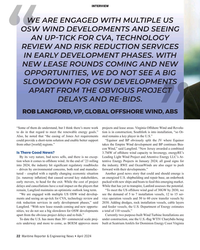 )
April 2024 - Maritime Reporter and Engineering News page: 22
)
April 2024 - Maritime Reporter and Engineering News page: 22INTERVIEW WE ARE ENGAGED WITH MULTIPLE US OSW WIND DEVELOPMENTS AND SEEING AN UP-TICK FOR CVA, TECHNOLOGY REVIEW AND RISK REDUCTION SERVICES IN EARLY DEVELOPMENT PHASES. WITH NEW LEASE ROUNDS COMING AND NEW OPPORTUNITIES, WE DO NOT SEE A BIG SLOWDOWN FOR OSW DEVELOPMENTS APART FROM THE OBVIOUS
-
 )
April 2024 - Maritime Reporter and Engineering News page: 18
)
April 2024 - Maritime Reporter and Engineering News page: 18operations, with three Tier 1 SOVs, SOV and CSOV owners have generally sought pricing from two on long-term charter for operators and one for an OEM. Norwegian yards (who generally build the hulls in countries Construction and commissioning have been supported by including Vietnam, Turkey, Romania, and
-
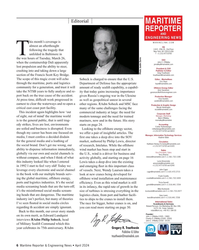 )
April 2024 - Maritime Reporter and Engineering News page: 6
)
April 2024 - Maritime Reporter and Engineering News page: 6Editorial MARITIME REPORTER AND ENGINEERING NEWS his month’s coverage is M A R I N E L I N K . C O M almost an afterthought HQ 118 E. 25th St., 2nd Floor following the tragedy that New York, NY 10010 USA T +1.212.477.6700 Tunfolded in Baltimore in the wee hours of Tuesday, March 26, CEO John C.
-
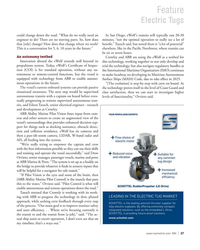 )
April 2024 - Marine News page: 37
)
April 2024 - Marine News page: 37Feature Electric Tugs could change down the road. “What do we really need an In San Diego, eWolf’s transits will typically run 20-30 engineer to do? There are no moving parts. So, how does minutes, “not the optimal operation to really see a lot of that [role] change? How does that change where we work?
-
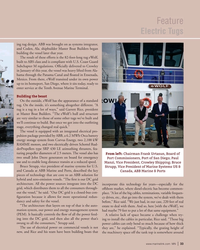 )
April 2024 - Marine News page: 33
)
April 2024 - Marine News page: 33Feature Electric Tugs ing tug design. ABB was brought on as systems integrator, and Coden, Ala. shipbuilder Master Boat Builders began building the vessel later that year. The result of these efforts is the 82-foot-long tug eWolf, built to ABS class and is compliant with U.S. Coast Guard Subchapter M
-
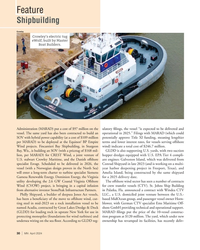 )
April 2024 - Marine News page: 30
)
April 2024 - Marine News page: 30was delivered from specialist Esvagt. Scheduled to be delivered in 2026, the Conrad Shipyard in late 2023 (and is working on a multi- vessel (with a Norwegian design proven in the North Sea) year harbor deepening project in Freeport, Texas), and will enter a long-term charter to turbine specialist Siemens
-
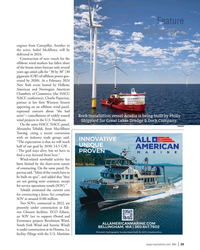 )
April 2024 - Marine News page: 29
)
April 2024 - Marine News page: 29amid calls for “30 by 30” (30 gigawatts (GW) of offshore power gen- erated by 2030). At a February 2024 New York event hosted by Hellenic American and Norwegian American Chambers of Commerce (the HACC NACC conference), Charlie Papavizas, partner at law ? rm Winston Strawn appearing on an offshore wind
-
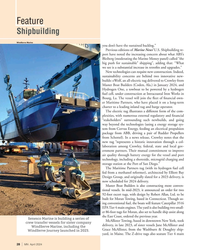 )
April 2024 - Marine News page: 28
)
April 2024 - Marine News page: 28Feature Shipbuilding WindServe Marine you don’t have the sustained backlog.” Previous editions of Marine News’ U.S. Shipbuilding re- port have noted the increasing concern about what ABS’s Bleiberg (moderating the Marine Money panel) called “the big push for sustainable” shipping”, adding that: “What we
-
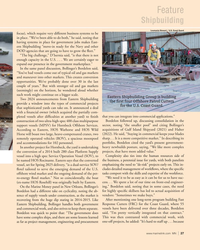 )
April 2024 - Marine News page: 27
)
April 2024 - Marine News page: 27Feature Shipbuilding Loumania Stewart / U.S. Coast Guard focus), which require very different business systems to be in place. “We’ve been able to do both,” he said, noting that having systems in place for government jobs makes East- ern Shipbuilding “move-in ready for the Navy and other DOD agencies
-
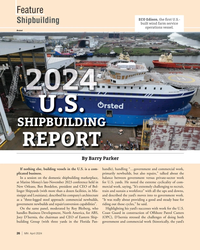 )
April 2024 - Marine News page: 26
)
April 2024 - Marine News page: 26Feature ECO Edison, the ? rst U.S.- Shipbuilding built wind farm service operations vessel. Ørsted U.S. SHIPBUILDING REPORT By Barry Parker If nothing else, building vessels in the U.S. is a com- handle), handling “…government and commercial work, plicated business. primarily newbuilds, but also
-
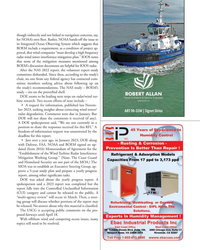 )
April 2024 - Marine News page: 25
)
April 2024 - Marine News page: 25though indirectly and not linked to navigation concerns, say, for NOAA’s own ? eet. Rather, NOAA hands-off the issue to its Integrated Ocean Observing System which suggests that BOEM include a requirement, as a condition of project ap- proval, that wind companies “must develop a high frequency radar
-
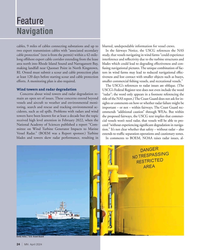 )
April 2024 - Marine News page: 24
)
April 2024 - Marine News page: 24Feature Navigation cables, 9 miles of cables connecting substations and up to blurred, undependable information for vessel crews. two export transmission cables with “associated secondary In the fairways Notice, the USCG references the NAS cable protection” (text is from the permit) within a 42-mile-
-
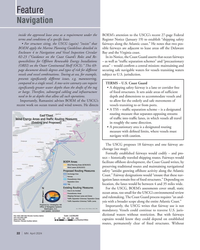 )
April 2024 - Marine News page: 22
)
April 2024 - Marine News page: 22Feature Navigation inside the approved lease area as a requirement under the BOEM’s attention to the USCG’s recent 27-page Federal terms and conditions of a speci? c lease. Register Notice (January 19) to establish “shipping safety • For structure siting, the USCG (again) “insists” that fairways along
-
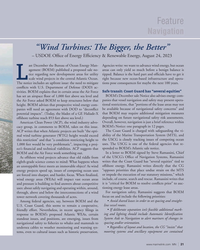 )
April 2024 - Marine News page: 21
)
April 2024 - Marine News page: 21Feature Navigation “Wind Turbines: The Bigger, the Better” – USDOE Of? ce of Energy Ef? ciency & Renewable Energy, August 24, 2023 ast December the Bureau of Ocean Energy Man- Agencies write: we want to advance wind energy, but ocean agement (BOEM) published a proposed sale no- areas can only yield so
-
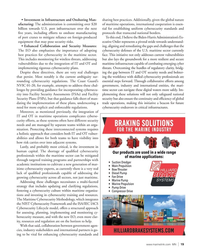 )
April 2024 - Marine News page: 19
)
April 2024 - Marine News page: 19• Investment in Infrastructure and Onshoring Man- sharing best practices. Additionally, given the global nature ufacturing: The administration is committing over $20 of maritime operations, international cooperation is essen- billion towards U.S. port infrastructure over the next tial for establishing
